The Angled Surface in XYZ Plane Cycle
Introduction
This topic will explain the Angled Surface in XYZ Plane measure cycle, will describe how to access it, will explain the options found in it, and will explain how to use it with quick steps.
The Angled Surface in XYZ Plane Cycle

This cycle measures a planar surface whose normal is not parallel to the X, Y, or Z Axes. This cycle can utilize the following geometry inputs:
- Planar surface face whose normal is neither parallel to the X Axis, the Y Axis, nor the Z Axis.
Navigation
To access the Angled Surface in XYZ Plane cycle:
- In the CAM Tree, locate the desired Machine Setup for the Probing cycle, right-click the Machine Setup, and select Probing.
The Probing dialog launches in the Data Entry Manager. - Click the Operations(s) tab.
- Click the Parameters tab.
By default the Selected Geometry list is given focus to allow you to select geometry from the graphics area. - Select the applicable geometry.
The geometry is added to the Selected Geometry list and the Initial Position and Parameters section are populated.
Note: Some geometry may be applicable to several cycles. In these cases the cycle that is selected based on the geometry may not be the intended cycle. In these cases, simple choose the correct cycle from the drop down list.
The Data Entry Parameters
Parameters
-
X - determines the end point for the cycle along the X-axis of the current Work Offset.
-
Y - determines the end point for the cycle along the Y-axis of the current Work Offset.
-
Z Measure Height - determines the end point for the cycle along the Z-axis of the current Work Offset.
- Distance - determines the distance from the surface at which the probe will begin the cycle.
Options
- Output Value Option
 - With this check box cleared, the output will be the probe trigger points with no corrections.
- With this check box cleared, the output will be the probe trigger points with no corrections. - With this check box selected, you can adjust output values in variables #124, #125 and #126. It does not change the way cycle movements are performed as X,Y offsets are always considered. Choose from:
- With this check box selected, you can adjust output values in variables #124, #125 and #126. It does not change the way cycle movements are performed as X,Y offsets are always considered. Choose from: - 0 - Spindle centre-line adjust. This is used for stylus XY calibration offset error correction only.
- 1 - Spindle center-line adjust. This is used for stylus XY calibration offset error correction and Z height adjustment by the ball radius value (i.e. the center of the ball).
- 2 - Surface contact point adjust along the approach vector. This is used for stylus XY calibration offset error correction and radius correction along the XYZ approach vector.
Quick Steps - Angled Surface in XYZ Plane
- In the CAM Tree, locate the desired Machine Setup for the Probing cycle, right-click the Machine Setup, and select Probing.
The Probing dialog launches in the Data Entry Manager. - Update the Material Approach and Feature Parameters as necessary.
- Click the Operations(s) tab.
- On the Probe page, select, or define, the Probe to be used.
- Click the Parameters tab.
By default the Selected Geometry list is given focus to allow you to select geometry from the graphics area. - Select the desired piece(s) of geometry.
The geometry is added to the Selected Geometry list and the Initial Position and Parameters section are populated.
Important: The available cycles are filtered by the geometry selected. If you selected geometry and do not have the desired cycle available, remove the geometry and reselect geometry compatible with the cycle.
- Update the Initial Position and Parameters sections as needed.
- Click the Options tab and update any options necessary.
- Click OK.
Example - Angled Surface in XYZ Plane
In this example we:
- Select the Probe feature.
- Select a probe for the cycle.
- Update the Machining Data and Feed groups.
- Select the cycle.
- Adjust the Parameters.
- Utilize the Options page.
- Backplot the result.
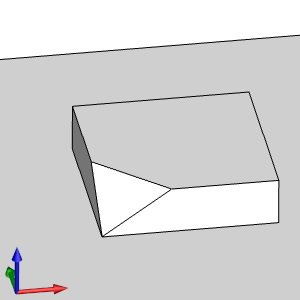
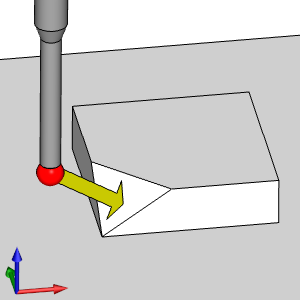
Part 1) Selecting the Probe feature
The first step of any Probing cycle is to create a Probing feature in the Machine Setup it is intended to be used in.
- In the CAM Tree, locate the desired Machine Setup for the Probing cycle, right-click the Machine Setup, and select Probing.
The Probing dialog launches in the Data Entry Manager.
Part 2) Selecting the Probe
Selecting a probe can be done with the following steps, or by simply deselecting the System Tool check box and inputting the appropriate data into the required fields.
- By default Measure is already in the Current Operations list. This will give us access to all available measure cycles in the Operation(s) tab.
At the top of the dialog, click the Operation(s) tab. - By default the Probe page is active. In this page, click the Tool Crib button.
The Tool Crib dialog launches. - Select your probe from the Tool Crib.
- If a probe has not yet been added to your Tool Crib, select the Add From Tool Library button and select one.
- If a probe has not yet been added to your Tool Library, select the
 Add button, define the probe in the Tool Parameters section, and select OK.
Add button, define the probe in the Tool Parameters section, and select OK.
The probe is added to the Tool Library and is automatically highlighted. - Click OK.
The probe is updated in the dialog.
- If a probe has not yet been added to your Tool Crib, select the Add From Tool Library button and select one.
Part 3) Updating the Machining Data and Feed groups
When selecting a tool from the Tool Crib, a tool number, and the Height and Diameter Offsets should already be correct. However, if you need to update them, you can do that in the Machining Data group. The Feed group will allow you to set a Protected Feedrate for the probe.
- Update the Machining Data as needed:
- Update the Tool Number if needed.
- To have the cycle update the Height and Diameter Offset, select the Override Offset button and enter the values to update the offsets to.
- Update the Tool Number if needed.
- Update the Protected Feedrate in the Feed group as needed.
Part 4) Selecting the Cycle
The cycle can be selected with the drop down list under the Cycles section, but simply selecting the appropriate geometry will usually select the required cycle automatically. Since certain geometry could be applicable to several cycles, in some cases, the list will become much smaller.
- Click the Parameters tab.
By default the Selected Geometry list is given focus to allow you to select geometry from the graphics area. - Select a planar surface whose normal is parallel with the X, Y, or Z Axes.
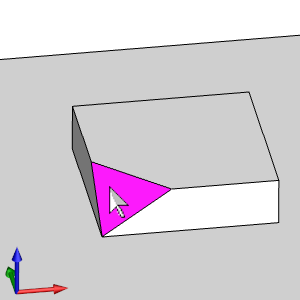
The geometry is added to the Selected Geometry list, the Initial Position and Parameters section are populated, and the toolpath becomes visible.
Part 5) Updating the Parameters section
The Parameters section for this cycle consists of the Z Measurement Height, X and Y values, and the Distance value. In this case we do not really need to adjust the height at which the probe will make contact. The X and Y values could be adjusted to update the point at which the probe will make contact, but will be left as they are for this example. For this example will update the Distance.
- In the Parameters group, update the Distance value by adding -0.5 to the end, and pressing Tab.

The value and the toolpath update to put the initial position of the probe a half inch further back in X.
Part 6) Utilizing the Options page
The values in the Options page should only be utilized if you are familiar with exactly how the individual options work.
- Click the Options tab.
- Update any and all options that are needed for the cycle.
- Click OK to exit the dialog.
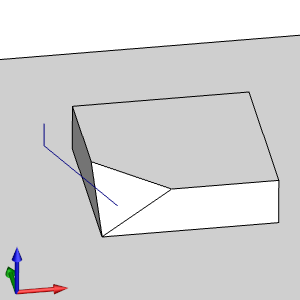
The dialog closes and the Probing feature is added to the CAM Tree.
Part 7) Backploting the result
The Backplot is a great way to verify the movements of any of the operations you create.
- In the CAM Tree, right-click the C Measure operation in the Probing feature and click Backplot.
The Backplot dialog launches. - Click Next to view the probe movements.

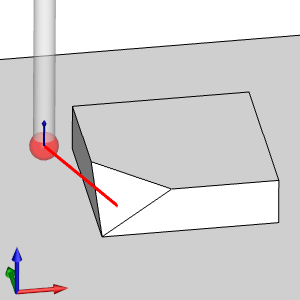
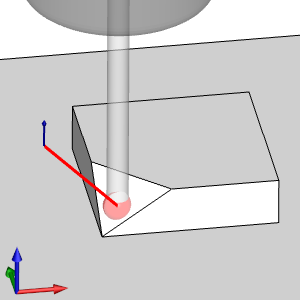
- Click Close.
The dialog is closed and the feature is ready to post.






